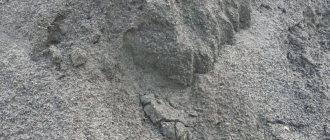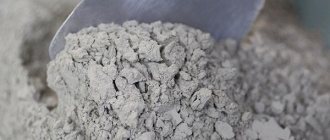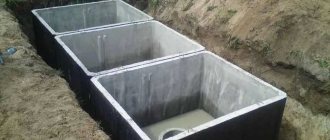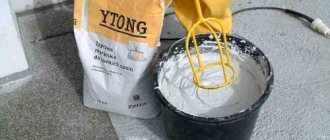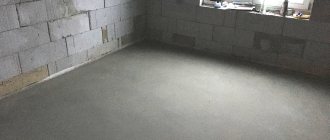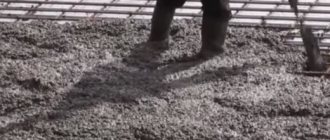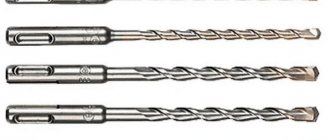I want to explain what screening is, since more than once I have had to deal with the fact that it was confused with crushed stone. And these were not amateurs, but people who already had some experience in construction. In order not to delay, I’ll just give a definition right away: the screening has a fraction of no more than 10 mm, and everything else will look like one or another building material. Such a small fraction is formed when the stone is crushed, but there are also larger fragments, but the fines are sifted out.
Types of dropouts
The product is obtained after sifting crushed rock. The size of the fractions is 0.1-5 mm. The color is affected by the type of raw material. It can have shades of red and gray.
The type of screening is influenced by its composition and grain size. The material classification is represented by three types.
Granite
Particle size is 0.1-5 mm. Among the components of granite screening there are no admixtures of clay, dust, or organic inclusions (0.4% of the total weight). Bulk density is within 1330 kg per 1 cubic meter. Low flakiness (presence of flat grains) increases the performance characteristics of seeding.
Gravel
Grain size - 0.14-0.25 mm. The impurities contained in the screenings are no more than 0.6%. Bulk density - 1400 kg per cubic meter. The sedimentary substance has a strength of M800-1000 due to its loose structure. Its adhesion to other substances in building mixtures is lower than that of granite screenings.
Application:
- in the road area: road base, composed of asphalt;
- in construction: adding to concrete;
- for decorative purposes: filling for paths;
- utilities use gravel sand during icy conditions.
Limestone
The grain size is 2-5 mm. Impurities make up up to 2% by weight. Bulk density - 1300 kg. The disadvantage of the material is low strength (can vary from M400 to M800). The substance dissolves in water and has astringent properties.
Application:
- in construction and finishing of premises: it is a component of the cement mixture (plaster, facing tiles, and blocks for walls are made from it);
- in agriculture: food additive, soil fertilizer;
- in the municipal sector: ice topping (anti-slip property).
Gravel Crushing Product
Unlike granite, which is also a natural inorganic rock, gravel contains mineral inclusions.
For this reason, gravel loses its due strength. The screening size reaches 2 mm, the admixture of dust and organic matter is 0.5-0.7%.
Application areas for gravel screening:
- Restoration of the roadway, production of asphalt paving. Gravel screening is also widely used for arranging pedestrian paths and garden areas.
- Screenings of this type are actively added to the concrete solution used for pouring workshops, industrial premises, and warehouses. However, due to the low strength, the load on this type of fill should be limited.
- In winter, stone chips are used for anti-slip protection by utilities.
A very popular area in which gravel screening has found application is landscape design. The presence of mineral impurities gives such coarse sand a beautiful sheen and variety of colors, which is used to decorate gardens and flower beds.
Advantages of using granite screenings
The material's resistance to temperature changes (withstands 300 cycles of freezing and thawing), durability, environmental safety and variety of shades have made it popular in construction and decorative design of park areas.
The advantages of the product also include the following factors:
- The material allows you to create areas with color accents in your landscape design.
- Seeding paths do not accumulate rainwater on the surface.
- Small elements fill the gaps that appear between the parts during the process of laying paving slabs.
- The price of screening raw materials is lower than crushed stone, while maintaining the qualities of the original raw materials.
Basalt screenings (material of volcanic origin) have similar technical characteristics. Used along with granite.
Concrete from screenings and cement, what are the proportions. where to apply
Any construction is an expensive business, and all developers have a desire to save money without losing quality. This can be done when constructing screeds, blind areas, paths and even foundations, if you mix concrete from screenings and cement. The proportions of such a solution are very important; violation of them can lead to a decrease in the strength of the concrete monolith. No less important is the composition of the filler used, its purity, grain size, and technology for preparing the mixture.
Application area
Screening is a fine-grained type of granite crushed stone. It is used in the following areas:
- in the production of reinforced concrete concrete, sidewalk tiles, water gutters;
- in the production of construction and finishing materials;
- as part of an asphalt-concrete mixture during road construction;
- as an anti-slip agent for ice.
Being an environmentally friendly material, it is used for water filtration.
Advice from professionals
To give you a better idea of the technology for preparing mortar from cement powder and screenings, we have prepared several useful videos. These videos also contain useful tips from experienced builders on preparing concrete mortar from waste material:
With the correct selection of proportions and the use of high-quality components, a concrete solution mixed using screenings will not be inferior to a traditional cement-sand-crushed stone mixture. At the same time, significant cost savings are achieved, which makes the use of screening in construction a justified solution. Good luck with your work!
Source
Basic material parameters
The characteristics of granite screening must comply with the standards of GOST 8267-93 and GOST TU 5711-002-03987691-2004, which are as follows:
- Dimensions - from 0.1 to 5 mm.
- Strength grade: M1200. The indicator indicates its high degree.
- Radioactivity - 158 Bq per 1 kg.
- The proportion of impurities in the composition should not exceed 0.4%.
- Flakiness - 14-19%.
- Frost resistance index - F300.
- Bulk density - 1300 kg per 1 cubic meter.
- Density and weight of granite screenings
Knowledge of these characteristics is necessary to calculate the amount of material.
Density is the own mass of screenings per 1 volume unit (cubic meter) that it occupies. 2 types of density are taken into account:
- natural (true) determines the actual volume of particles, ranging from 2615 to 2620;
- bulk - takes into account the amount of air in the voids (up to 50% of the mass), averages 1330.
The indicator depends on the size and shape of the grain, humidity and the amount of impurities.
Observe the following conditions:
- do not change the proportions to increase the proportion of cement. This will not make the finished mixture any stronger;
- the screenings should not contain yellow inclusions - silt, clay. It is not recommended to use graphite screening (black). The finished path or platform will not last long, will be actively washed away by snow and rain, and destroyed under the influence of heels.
If you do not want to completely remove sand from the concrete mixture, it is recommended to use the following proportions:
1 part cement M400 x 3 parts sand x 3 parts crushed stone x 2 parts screenings. Water - no more than 20% of the total volume.
In this case, the main function of granite or stone chips is to fill voids, increase strength and improve adhesion between sand and standard crushed stone.
The concept of specific gravity, its calculated parameters
Specific gravity is defined as the ratio of the mass of the raw material to its volume. Depends on the size of the fractions and the density of screenings. A description of the material is contained in the manufacturer's accompanying documents.
Flakiness (needle-like, plate-like particles) is important when determining weight. The severity of the material depends on the level of the grain plane. The cubic structure of the stone is the optimal shape for sowing.
Calculations are needed when purchasing material. Knowing the parameters will help determine the volume of goods. When ordering, use a correction factor that is equal to 1.1 (10% reserve).
The table shows the dependence of weight on fraction size.
| Fraction size (mm) | Weight (t/1 cubic meter) |
| 0,1-4,8 | 1,41 |
| 4,9-5 | 1,33 |
Smaller grains are heavier in weight than larger fractions for the same unit of volume.
Comparison
It is clear that if the production of screening requires a whole complex of various operations, machines and units (blasting operations, crushers, screens), then its cost is much higher than the cost of sand, which is most often simply scooped out of a quarry with an excavator. Indeed, sand is sold at prices several times lower than the cost of crushed stone. It is interesting that when selling crushed stone, a concept such as “bulk weight” is used. This means that a cubic meter of screenings (fraction 0-5, where the grains are located close to each other and fill the volume as much as possible) will weigh more than a cubic meter of fraction 60-100, where there will be a lot of free space between the grains (actually cobblestones). The bulk weight of sand and screenings is almost the same. Well, perhaps now we fully understand the difference between sand and screenings.
Dropout fraction
Crushed stone obtained by crushing rock is classified according to grain size. The smallest particles (not exceeding 5 mm) are separated by sieving. In appearance, the seeding resembles sand. Its amount can be 16-20% of the total mass.
It is often believed that raw materials such as screenings are identical to sand. But these are different types. Sand is a sedimentary rock. Screenings are a product of the crushing plant. When cleaning alluvial sand from impurities, sand screenings are formed. This material should also not be confused with granite crushed stone screenings.
How to use granite or gravel screening
Industries where rock seeding is used are housing and road construction, landscape design.
In the construction of private houses and large premises, blocks containing screened raw materials are used.
The advantages of the material include:
- low price,
- ease of transportation,
- the ability to increase the area of the building and reduce the load on the base due to the small thickness of the block.
Ease of installation reduces construction time.
Reinforced concrete products containing screening material have increased wear resistance.
Concrete with screening particles is flexible in work. It is used in forming the foundation, pouring the floor and is used in the manufacture of curbs and paving slabs. The products are durable and water resistant.
Use of crushed stone screenings in landscaping landscaping areas
In road construction, gravel seeding is used for filling roadsides. Granite components are part of asphalt concrete. The fine fraction reduces slip on the surface.
All shades of seeding are used in the decorative design of paths. No cement is used in the coating. To avoid spreading of the bedding, the sides are limited by curbs. The coating can be washed when dusty.
Fine granite chips are suitable for sprinkling children's and sports fields. The environmentally friendly surface has the property of water absorption (rain puddles do not remain) and does not create dust.
A new direction for using screenings is as part of reagent mixtures. The particles have good adhesion to the icy road surface. Abrasive elements prevent slipping of car tires and shoe soles. Road authorities prefer gravel sand. Its properties are not much inferior to granite, but the price is lower. The advantage is that small elements fill small cracks in the road surface during the melting period.
Proportions of components for plastering walls
Screening makes the plaster mortar more durable. Strength can be increased by approximately 1.25-1.5 times compared to sand. Therefore, cement consumption when using screenings is reduced by 1.5 times.
When producing cement mortar for plaster based on screenings, the ratio of components will be as follows (cement: screenings):
Limestone screenings can be used as an additional binder. It improves the adhesion of plaster and increases the plasticity of the solution. In addition, limestone has antiseptic properties and prevents the growth of fungi. Plaster with limestone also provides additional thermal insulation. In a room with such a coating, humidity is reduced.
To prepare the solution, you need to take cement, limestone flour (or very fine screenings with a particle diameter of up to 1.5-2 mm) and sand. The ratio of components here is 1:2:6. You need to add another 1.4 parts of water to the dry mass.
Let's look at the ratio of components using specific examples:
For 10 liters of cement, 20 liters of fine limestone screenings and 60 liters of sand are required. To this mass you need to add another 14 liters of water. As a result, you will get approximately 60-62 liters of solution.
Lime-cement plaster can also be prepared using slaked lime, replacing sand with screenings.
The ratio of components here will be as follows (cement: lime: sand):
To prepare a mortar with strength M150 you will need 10 liters of cement, 2 liters of slaked lime and 43 liters of screenings. You need to add another 14 liters of water to the material. From this mass you will get approximately 43-45 liters of plaster mortar.
For plastering, large volumes of mortar should not be prepared, as it hardens quickly and is poorly applied to the wall. The consistency of the solution should resemble thick sour cream. A mixture that is too dry will stick to the surface and is difficult to level, while a mixture that is too liquid will flow down the wall.
Screening is a good option for finishing the interior and exterior walls of a home. By adding it to the solution, you can save on cement. And if you consider that in some regions screening costs almost twice as much as sand, then the final price of plaster will be even lower. At the same time, the quality of work will not suffer at all. The main thing is to sift the material before use so that it does not contain large impurities.
Source
Cost of crushed stone
The price of crushed granite depends on the size of the elements. Varies between 1120-3600 rubles. for 1 cubic meter The cost of screening is from 520 rubles. per m3. The by-product retains the properties of the parent rock. Depending on what was used in the production of concrete - screenings or crushed stone - the price will be determined.
Fine-grained screenings are secondary raw materials obtained during the production of crushed stone using the screening method. Seeding has technical characteristics that do not differ from the base material. It is used in various fields of construction and landscape design. Durability, ease of use, frost resistance, and low price have made granite screenings a popular product.
